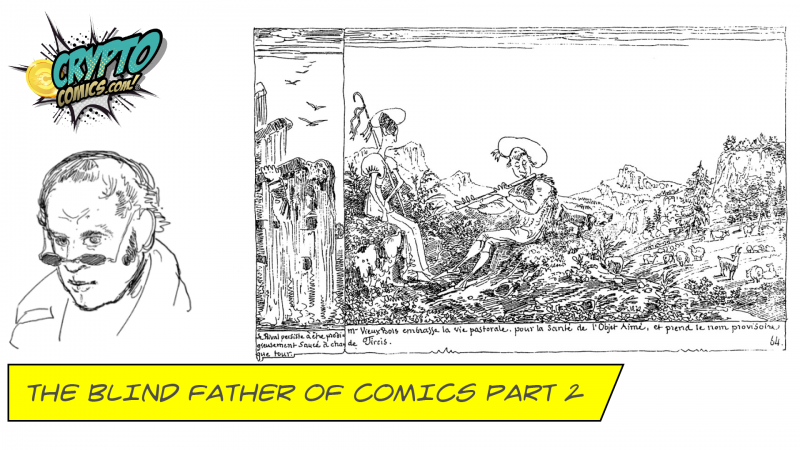by Matthew Russell - Posted 1 year ago

Welcome back my CryptoComics Compatriots. Last week we talked about the early life of the creator of comics Rodolphe Töpffer. This man was a genius who turned his disability into a historic strength. Let’s just dive into where we left off.
Despite his innovative work in creating what would later be recognized as comic strips, Töpffer was initially hesitant to publish them. There were several reasons for this reluctance:
Artistic and Literary Standards: Töpffer was acutely aware of the prevailing artistic and literary standards of his time. His comic strips, with their caricature-style drawings and humorous narratives, deviated significantly from these norms. He feared they might not be taken seriously or might even be dismissed as trivial.
Concern Over Reputation: As a respected educator and intellectual in Geneva, Töpffer was concerned about how publishing these "lighter" works might impact his professional reputation. He worried that they might undermine his standing in the more serious and scholarly circles.
Uncertain Public Reception: The format of his comics was untested and unconventional. Töpffer was unsure how the public would receive this novel blend of visual and textual storytelling. With the exception of his students, there was no real test audience.
Johann Wolfgang von Goethe, born on August 28, 1749, in Frankfurt, Germany, emerged as one of the most influential figures in Western culture and a giant in the world of literature. His prolific contributions spanned poetry, drama, literature, theology, humanism, and science, earning him acclaim as the greatest German literary figure of the modern era.
Goethe's impact was not confined to writing alone; he was a statesman, serving in various capacities in the court of Weimar, and a scientist with significant contributions in botany and color theory. His relationships with other intellectuals like Friedrich Schiller and his involvement in movements like Sturm und Drang and Weimar Classicism underscored his central role in European intellectual discourse.
His magnum opus, "Faust," a two-part dramatic poem, encapsulated his deep philosophical explorations and quest for knowledge. Goethe's exploration of the human condition, combined with his commitment to personal and intellectual growth, rendered his work timeless, influencing generations of philosophers, psychologists, and artists.
In the world of comic strips, Goethe's role was unexpectedly pivotal, particularly in the career of Rodolphe Töpffer. Töpffer, fearful of publishing his work due to the critical eye of prominent art critics like Goethe, who was known for his skeptical view of new art forms, had avoided releasing his comics. However, a serendipitous encounter changed this trajectory.
One of Töpffer's friends presented Goethe with a copy of "Histoire de Mr. Vieux Bois," Töpffer's comic strip. Contrary to Töpffer's fears, Goethe was thoroughly impressed. He found Töpffer's combination of images and text refreshingly engaging, a sentiment he expressed in a letter. This endorsement from Goethe, a respected figure known for his critical acumen, provided Töpffer with the much-needed validation and encouragement to publish his work.
Goethe's admiration was not just a personal opinion; it served as a powerful affirmation from one of the age's most respected literary figures, propelling Töpffer to overcome his apprehensions and contribute significantly to the evolution of comic strips.
Goethe's approval had a profound effect on Töpffer: It gave him the confidence that his work had artistic and literary merit, despite its unconventional nature. Goethe's endorsement helped legitimize comic strips as a form of literary and artistic expression, paving the way for their acceptance in broader cultural circles.
Encouraged by Goethe's response, Töpffer finally decided to publish his works. The first of these, "Histoire de Mr. Vieux Bois," was published in 1837 and met with considerable success, marking the beginning of a new era in the history of comics.
In conclusion, Töpffer's initial fears about publishing his comic strips were overturned by the unexpected admiration of Johann Wolfgang von Goethe. This pivotal moment not only propelled Töpffer into the public eye but also played a crucial role in establishing the comic strip as a legitimate and influential form of storytelling.
I know that this was a long one, so thank you for sticking with me this far.
There is still so much to the story. I would love to write more about how his work still influences comic artists today, his pivotal works, and how he spent the rest of his life. I would love to go into depth into “The Adventures of Obadiah Oldbuck” (the world’s first comic and his later book “Essai de Physiognomonie", documenting his reflections and experience writing and drawing comicsThis is truly a fascinating man.